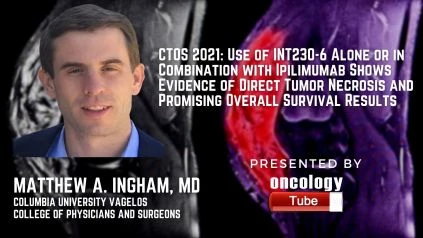Matthew A. Ingham, MD, Assistant Professor of Medicine in the Division of Hematology and Oncology at Columbia University Vagelos College of Physicians and Surgeons speaks about Intensity Therapeutics Reports Use of INT230-6 Alone or in Combination with Ipilimumab Shows Evidence of Direct Tumor Necrosis and Promising Overall Survival Results in Adult Subjects with Metastatic Sarcomas at the Connective Tissue Oncology Society (CTOS) 2021 Virtual Annual Meeting.
Intensity Therapeutics, Inc., a clinical-stage biotechnology company focused on the discovery and development of proprietary immune-based intratumoral cancer therapies designed to kill tumors and increase immune system recognition of cancers, announced today that data from its open-label Phase 1/2 study of its novel lead asset, INT230-6, as a monotherapy or in combination with ipilimumab in adult subjects with metastatic sarcomas, is being presented in an oral presentation today (CTOS).
Title: Safety and Efficacy in Adults with Metastatic Sarcomas from a Phase 1/2 Study of Intratumoral INT230-6 Alone or in Combination with Ipilimumab [INTENSITY# IT-01; BMS# CA184-592] (NCT 03058289)
The presentation will be available on Intensity’s website under “Publications, Papers, and Posters” at https://intensitytherapeutics.com/news/publications-papers-and-posters/.
Results from 19 patients with various metastatic sarcomas who were treated with INT230-6 as a monotherapy (n=10) or in conjunction with a checkpoint inhibitor (n=8), mostly ipilimumab, were presented. The cancers of the included patients advanced after a median of three prior lines of therapy (range 0 to 9) that included all approved, suitable medications for their specific cancer. Subjects in the monotherapy and checkpoint inhibitor combo arms had similar demographics. With repeated intratumoral injections in numerous tumors, the cumulative dose of INT230-6 IT injections ranged from 20 to 530mL (265mg cisplatin, 53mg vinblastine). For cisplatin, SHAO, and vinblastine, pharmacokinetic (PK) profiles from 18 STS individuals in trial IT-01 were evaluated, and fewer than 5% of the medicines entered the bloodstream.
In a retrospective exploratory examination of individuals, INT230-6 dosed at greater than or equal to 40% of their incoming total tumor burden was compared to INT230-6 dosed at less than or equal to 40% of their entering total tumor burden, indicating promising survival. At one year, roughly 60% of sarcoma patients who received a dosage of >40% of their entire tumor burden will still be alive. These findings compare favorably to those reported in previous Phase 1/2 sarcoma studies, in which around half of the individuals die between 3 and 8 months depending on prognostic variables (ECOG, LDH, number of metastatic locations). Abscopal effects were observed in two participants with visceral lesions, which may be an understatement given that no tumors under 1 cm and not all larger lesions were followed.
Immunohistochemistry examination of three INT230-6 monotherapy STS individuals’ paired (pre-and 28-day post-dose) biopsy of injected lesions revealed a median 60 percent reduction in tumor cell content and a 72 percent reduction in Ki67 positivity (proliferation marker).
After two injections of INT230-6, hematoxylin and eosin analyses revealed significant decreases in cancer cells in biopsies from monotherapy individuals when compared to baseline. With a few low-grade immune-related side effects, local administration of INT230-6 as monotherapy into tumors generated an immune response with increases in activated CD4+ and CD8+ T-cells in the tumor. Immune observations from in vivo models corroborate these clinical outcomes. Pain at the injection site (68.4 percent of patients), weariness (42.1 percent), and decreased appetite were the most common low-grade and temporary side effects (36 percent ). There were no treatment-emergent adverse events of grade 4 or 5 and no dose-limiting occurrences.

